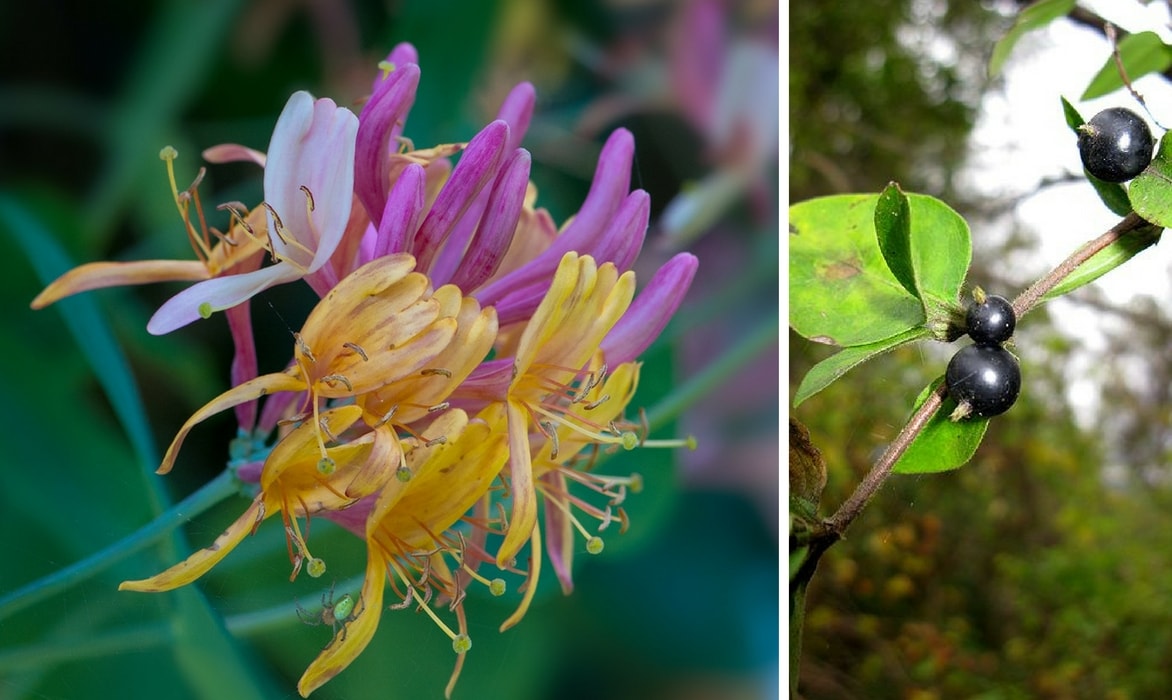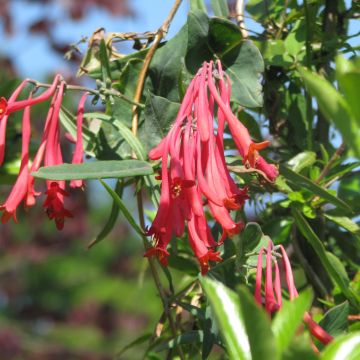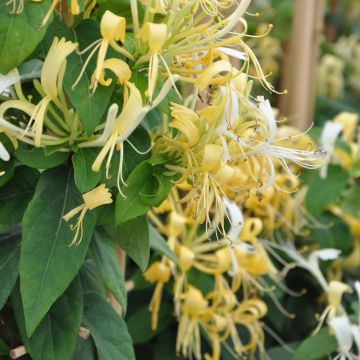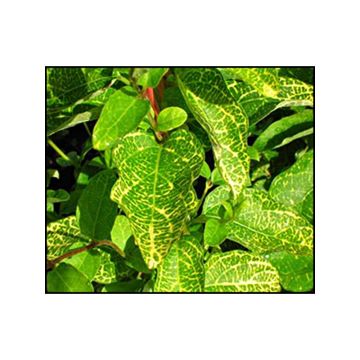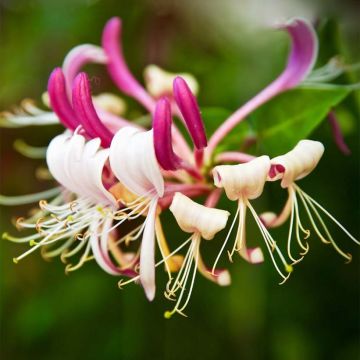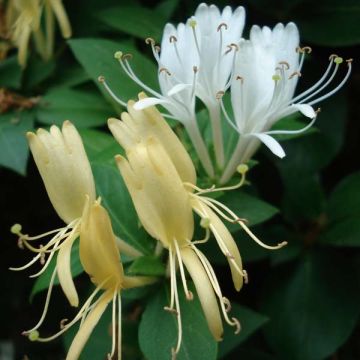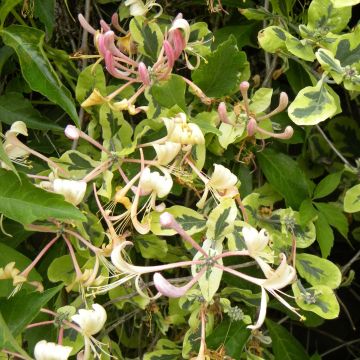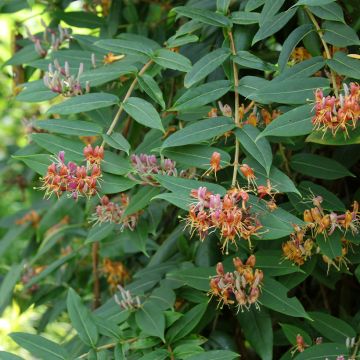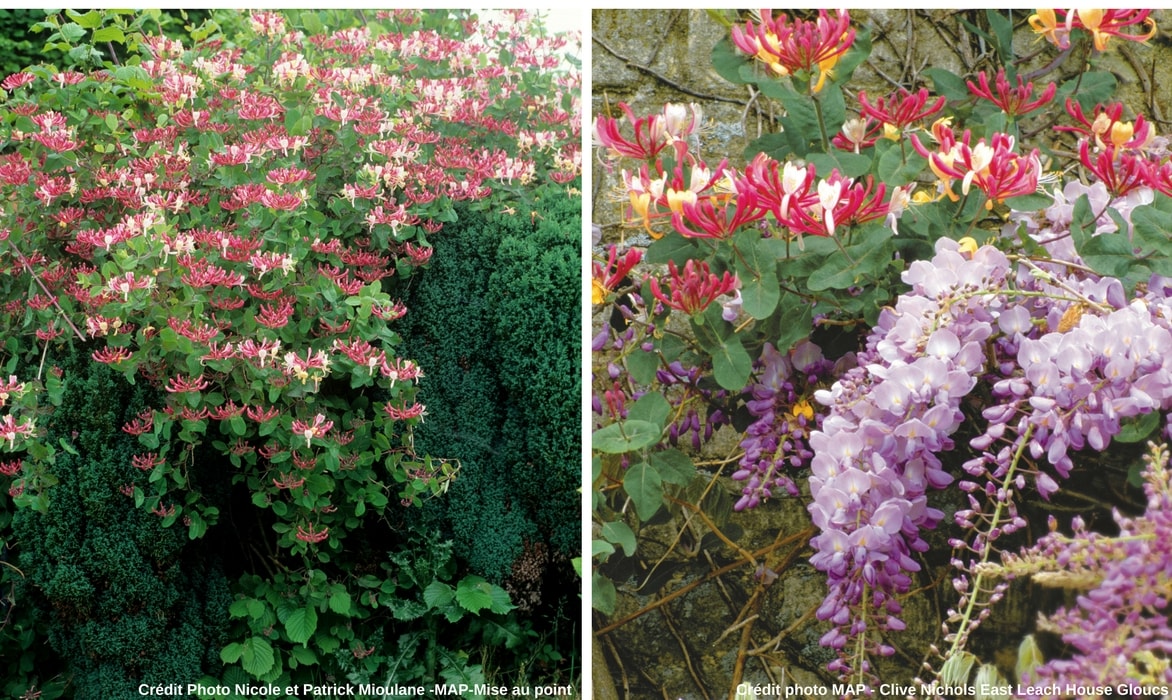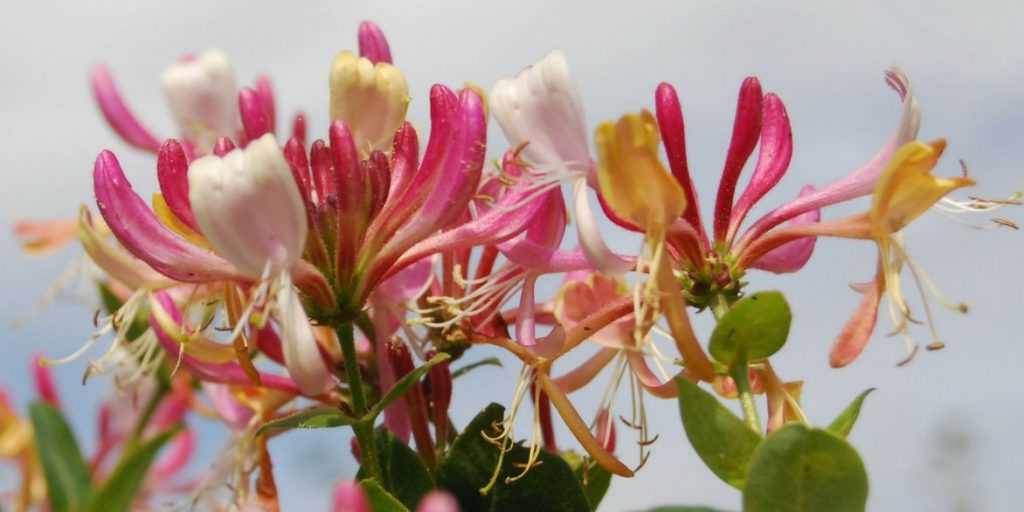
Honeysuckle: Planting, Pruning and Care
Contents
Honeysuckle, in a few words
- Honeysuckle is a charming climbing plant, its flowers exude an unmistakable fragrance.
- It is easy to grow, fast-growing and has a very prolonged flowering period depending on the species and varieties.
- It tolerates a wide variety of soils and climates.
- It requires little maintenance and is rarely affected by diseases or pests.
- It’s perfect for quickly covering a trellis, pergola or enlivening a single-species hedge.
- It can be grown both in the ground and in large pots, and is easily propagated by cuttings or layering.
Our Expert's Word
The Honeysuckle (Lonicera), is well known to gardeners in its climbing form. A large, woody and twining vine, it boasts an unmistakable fragrance. It’s an easy-to-grow climbing plant, fast-growing, and offers genuine winter, spring or summer interest depending on the chosen variety or species. With so many Honeysuckles available, there are at least two or three suited to every situation, soil type and climate.
When climbing, Honeysuckle produces stems that can reach 2 to 10m in length within just a few months, making it ideal for covering trellises or fences. It features deciduous or evergreen foliage depending on the variety, and produces beautiful white, yellow, orange, pink or red flowers. These are typically very fragrant, particularly in the evening.
While Honeysuckle may not be considered an exceptional must-have plant, it certainly earns its place in every garden. It quickly becomes an obvious choice for semi-shaded or even fully shaded areas, which it often tolerates very well. Its success depends mainly on careful initial planting, as this plant proves very tolerant of different soil types. Highly adaptable, it thrives equally well in large containers or in open ground. It requires minimal maintenance, needing only annual pruning when it threatens to outgrow its allotted space.
Botany
Botanical data
- Latin name Lonicera
- Family Caprifoliacées
- Common name Chèvrefeuille, Camérisier
- Flowering Floraison de mai à octobre, selon les espèces, fleur à 2 lèvres et tube court, de 3 à 15 cm de long, inflorescence en verticilles.
- Height de 2 à 25 mètres - Envergure variable
- Exposure Exposition ombre claire, mi-ombre ou soleil selon les espèces
- Soil type tolérant, profond, souple
- Hardiness au-delà de -15 °C à peu rustique selon les espèces
Honeysuckle, in Latin Lonicera, is a highly polymorphic genus from the Caprifoliaceae family, which also includes Abelia, Weigela, and Scabious. This genus comprises around 200 species of climbing or shrubby plants, evergreen or deciduous, along with numerous hybrids and cultivars, mostly native to the Northern Hemisphere. Their natural habitat typically includes forest edges, woodland clearings, hedgerows, or embankments along sunken lanes.
Depending on their origin, these climbers show a preference for soils that are more or less moist or, conversely, very well-drained, even dry in summer. Generally speaking, Honeysuckles are tolerant of limestone or clay in the soil and adapt easily to all our climates. However, these plants do not tolerate salt spray or saline soils.
A twining woody-stemmed climbing plant, Honeysuckle will not exceed 2-3 metres in height for the smallest species like L. henryi or L.(x) brownii, but L. sempervirens and L. japonica can send stems up to 10 metres climbing their support.
The foliage, often decorative and lush, consists of entire, smooth leaves, oval to obovate in shape, 3 to 8 cm long, sometimes up to 15 cm in the giant L. hildebrandtiana. The foliage is deciduous, semi-evergreen, or evergreen, depending on the variety and climate. The leaves are arranged oppositely on the stems. Ranging from dark to light green, they are sometimes beautifully variegated, as in the Honeysuckle ‘Harlequin Sherlite’.
The flowering, often fragrant in warm weather and towards evening, lasts from May to October, depending on the plant. The flowers, composed of a tube flaring into two more or less divided lips, stand out for their very light, almost ethereal appearance. Their colour palette, often including white, ranges from yellowish-white to pink, orange, and even red, in solid, bicolour, or sometimes tricolour shades that change as the flower matures. This flowering is nectar-rich and attracts many pollinating insects.
The flowering is followed by the formation of small, fleshy, ovoid fruits of varying colours. These berries, slightly toxic to humans, are a delight for birds.
Read also
How to Prune a Honeysuckle?Main varieties
Thriving from cold regions to the tropics, often planted for its fragrance, Honeysuckle comes in 200 varieties, both climbing and shrubby. Among the climbers, here are some of the most commonly planted. Note that the most fragrant varieties are often those that lose their foliage in winter.
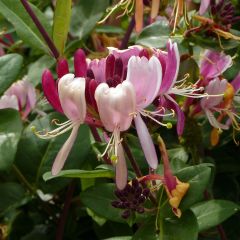
Lonicera periclymenum Serotina
- Flowering time August to October
- Height at maturity 5 m
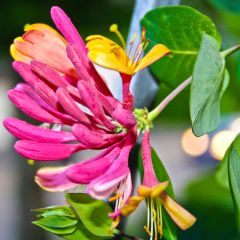
Lonicera x heckrottii Gold Flame - Goldflame Honeysuckle
- Flowering time July to October
- Height at maturity 3 m
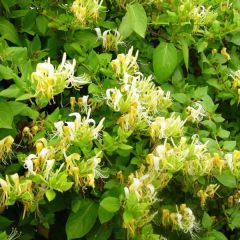
Lonicera japonica Hall's Prolific - Japanese Honeysuckle
- Flowering time August to October
- Height at maturity 6 m
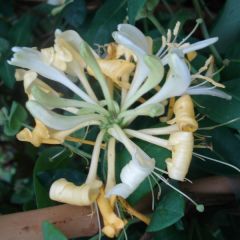
Lonicera periclymenum Scentsation - European honeysuckle
- Flowering time July to October
- Height at maturity 3 m
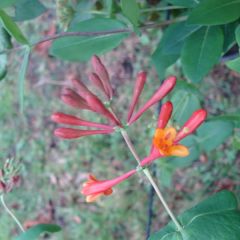
Lonicera x brownii Dropmore Scarlet
- Flowering time July to November
- Height at maturity 3,50 m
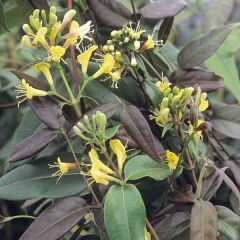
Lonicera henryi Copper Beauty - Henry's honeysuckle
- Flowering time July, August
- Height at maturity 2 m
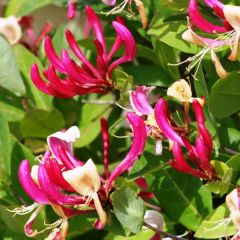
Lonicera periclymenum Fragrant Cloud - European honeysuckle
- Flowering time August to October
- Height at maturity 3 m
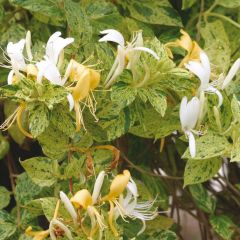
Lonicera japonica Mint Crisp
- Flowering time July to October
- Height at maturity 3 m
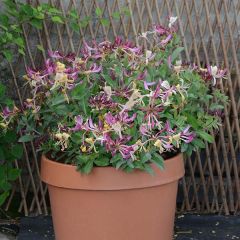
Lonicera periclymenum Chic et Choc - Common Honeysuckle
- Flowering time July to September
- Height at maturity 1 m
In dry soil, you can easily grow Lonicera etrusca, semi-evergreen with fragrant pink and yellow-orange flowers in June, and L. implexa, a Mediterranean variety, evergreen with yellow-pink flowers, white inside, blooming from May to July and lightly scented.
Finally, note that there are also many shrubby species and varieties, excellent as ground cover or hedge shrubs, such as Lonicera fragrantissima, which blooms in mid-winter, L. tartarica, adaptable to all climates, and L. nitida and its varieties, ideal for creating neat, dense low hedges quickly.
Discover other Honeysuckle
Planting
Where to Plant Climbing Honeysuckle?
Growing climbing honeysuckles is not particularly difficult; careful planting in deep, well-worked soil will result in vigorous growth. The chosen location should generally be partially shaded, away from scorching sunlight, under foliage or against an east-facing wall. It is especially important that the base of the plant remains shaded and cool. In the north of the country, planting in full sun is entirely possible, whereas in warmer regions, partial shade is essential.
Honeysuckles are not particularly sensitive to soil acidity (neutral, acidic or alkaline), but they do require varying degrees of moisture to support their flowering; they dislike overly poor and free-draining soils (very sandy or very stony, even rocky), or conversely, waterlogged soils saturated in winter. Ideally, they should be planted in humus-rich, well-drained soil that retains moisture in summer.
Hardiness varies depending on the species and hybrids, but most varieties commonly available in garden centres can withstand occasional frosts down to -15°C without issue.
Growing honeysuckle in pots is entirely possible, though it’s best to choose less vigorous varieties. Select a large container with drainage holes, with a minimum capacity of 30 litres, and a light, fertile substrate made from a mix of compost and garden soil, ensuring a layer of drainage material (gravel, clay pebbles) at the bottom of the pot. It is essential to monitor watering in summer and to apply slow-release fertiliser each year at the start of the growing season.
Honeysuckle is a climbing plant with twining stems, unable to attach itself to its support unaided. Its young green shoots should therefore be guided towards their support and tied with soft ties. The plant will then find its way through the gaps in a trellis, among tree branches, or around the frame of a pergola.
As with all young plants, watering should be monitored for the first two years after planting to ensure good establishment.
→ Learn more with Olivier’s video: planting honeysuckle
When to Plant?
Container-grown climbing honeysuckle can be planted throughout the year, preferably during cooler, well-watered periods and avoiding times of severe frost: from September to November in autumn, and from February to April in spring.
How to Plant?
- Dig a hole three times the height and width of the root ball. Loosen the bottom of the planting hole thoroughly with a pickaxe.
- Gently tease out the root ball at the edges to encourage root exploration and growth into the new substrate.
- Place the plant in the hole, slightly raising the crown (where the roots meet the stem) just above ground level.
- Backfill with a mix of compost and garden soil.
- Firm the soil around the plant, creating a shallow basin for watering.
- Water generously (at least 10 litres). Lightly firm the soil again.
- Water the same way the next day, then again a week later. During the establishment period, which lasts about two years, regular watering is essential, especially in dry and hot conditions.
Generally, plant one honeysuckle per square metre—its vigorous growth will quickly cover a bare fence or trellis.
Read also
How to Take Cuttings from Honeysuckle?Size and maintenance
Easy to grow and maintain, Honeysuckle will still benefit from a little attention to perform at its best, maintaining its vigour and flowering.
Pruning
While not essential, pruning honeysuckle may be necessary to balance its structure or densify its growth: wait until after flowering to carry out this light pruning, as flower buds appear on the previous year’s wood in most species.
A sparse plant can undergo severe pruning in late winter, before new growth begins.
Watering
Climbing Honeysuckle is generally not too demanding when it comes to water, depending on the species and variety, but it will always prefer moist soil, as it struggles with prolonged dry spells, especially when grown in pots.
Water regularly in summer and apply a thick mulch around the base in hot climates—this effective method helps reduce watering frequency.
Fertilising
Like many plants, Honeysuckle will grow more lushly and flower more abundantly if well-fed. An application of crushed horn or dried blood at planting time, then once a year in spring, will encourage vigorous growth and generous flowering.
Potential diseases and pests
Honeysuckle may fall victim to aphid attacks, which can be treated with pyrethrin spray in the evening.
The main disease that may affect this plant is powdery mildew, also known as white mould, a pathogenic fungus that is often specific to each plant species (tomato, vine, larkspur, etc.), capable of thriving in both cool and warm weather. Powdery mildew development is recognisable by whitish or greyish, powdery spots on the foliage. Good air circulation through the plant, an open growing position, and preventive or curative sulphur-based treatments are generally effective methods.
→ Christine explains in more detail honeysuckle diseases and pests
Propagation
Climbing Honeysuckles can be easily propagated by layering, by bending the stems to the ground while keeping them in contact with the soil, or by taking semi-ripe cuttings in summer or hardwood cuttings in autumn, which works very well.
Propagation by cuttings
First case: using semi-ripe cuttings in August:
- Using secateurs, cut sections of this year’s vigorous stems, bearing two sets of leaves. Trim the cuttings flush with the first set of leaves and 1 cm above the second set.
- Remove the lower leaves and insert the cutting into a well-moistened mix of compost and light soil, up to the remaining leaves.
- Place three ‘stakes’ in your pot, arranged in a triangle, then cover everything with a freezer bag, securing the base tightly to the outer edge of the pot with an elastic band. This is the ‘closed-case’ technique.
- Keep the pots in partial shade, occasionally adding water to a saucer placed beneath the pot if the growing medium appears too dry.
Second case: using autumn cuttings in October-November, with or without leaves:
- Depending on the chosen species or variety: cut a section of this year’s stem, about 30 cm long.
- Take 30 cm sections just below a node.
- Keep only the top two sets of leaves.
- Place the cuttings upright in rows in light soil enriched with sand and compost, kept moist but not waterlogged, burying them two-thirds deep. Choose a spot sheltered from cold winds.
Note: Fungal disease treatments slow down the formation and growth of new roots.
→ Learn more in our tutorial: How to propagate honeysuckle from cuttings?
Sowing
Sowing is possible, but the plant will take several years to flower. Moreover, this method does not guarantee the appearance of the resulting Honeysuckle if several species or varieties, grown close to each other, have hybridised through pollinating insects.
Association
Honeysuckles climb by twining their stems around various supports such as trees and sturdy pergolas (for the larger varieties), trellises and fence wire. Hardy, thriving in all our regions, simple yet graceful, they adorn the more neglected areas of the garden with their unmistakable fragrance, as sunny spots are usually reserved for Bignonias or Wisterias. A terrace or balcony can also be enhanced with a lovely specimen trained on a lattice or woven wooden panel, to screen an unsightly view or an intrusive neighbour, etc.
Annual Morning Glories make delightful companions for Honeysuckles. Though short-lived, they beautifully complement their lush foliage throughout the season, and their respective flower styles harmonise perfectly. Easy-to-grow perennial Sweet Peas also pair wonderfully with their rustic charm. Monospecific hedges, austere and composed of conifers or neatly trimmed laurels, will welcome these resourceful, unpretentious flowering vines, just as they host Clematis, which share similar qualities and cultivation requirements.
→ Discover more honeysuckle companion planting ideas in Christine’s advice sheet.
Did you know?
Honeysuckle, a nectar-rich plant, shelters a wealth of beneficial wildlife in the garden: various bumblebees, carpenter bees, and nocturnal butterflies, particularly the Hummingbird Hawk-moth, which pollinate it, drawn by the flowers’ fragrance that intensifies in the evening. It is also frequently visited by birds that relish its berries and help disperse the seeds.
It was once called Caprifolium, meaning “goat’s leaf” in Latin, due to these animals’ fondness for its foliage. The caterpillars of daytime butterflies, such as the Azure Hairstreak or the White Admiral, also live and feed on its leaves. Gourmets will appreciate the Honeyberry, the shrubby Lonicera kamtschatica, one of the few species producing edible fruits for humans, with berries resembling large blueberries.
While Honeysuckle berries are generally toxic, its stems and bark are used in herbal medicine for their detoxifying and cough-suppressing properties. In the past, its roots were used to extract a blue dye. In perfumery, Honeysuckle flowers are referred to as “mute flowers” because they contain so little essential oil that traditional extraction methods fail. Instead, perfumers recreate the scent from scratch using a carefully crafted blend of synthetic molecules. The fragrance of Lonicera fragrantissima is described as floral, sweet with jasmine-like notes, orange blossom, green undertones, and a honeyed richness.
Useful resources
- On our website, our extensive collection of Honeysuckles
- Discover Olivier’s video on planting Honeysuckle
- Our advice sheet: How to take honeysuckle cuttings?
- Our advice sheets: 5 climbing plants that won’t damage walls; 6 ideal climbing plants for shading a terrace
- Discover our selection of the most fragrant honeysuckles
- Our advice sheets: Honeysuckle, reliable choices; Honeysuckle, the most beautiful varieties
- Advice sheet: choosing a honeysuckle
- Subscribe!
- Contents



































